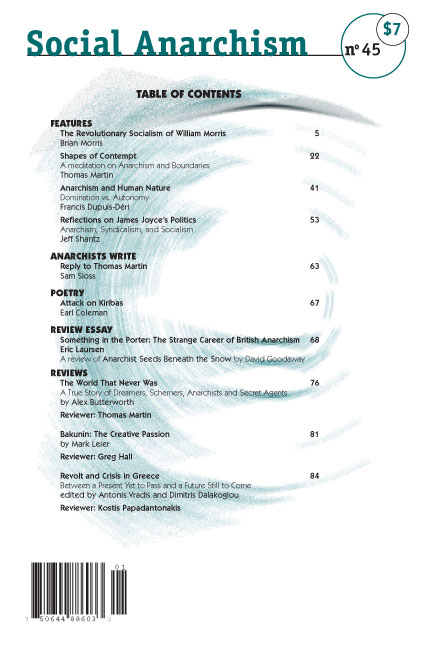Bakunin: The Creative Passion
Mark Leier
Leier, Mark. Bakunin: The Creative Passion. 350pp. New York: Thomas Dunne Books/St. Martin’s Press, 2006. $25.95 hardcover.
Faith in social revolution and belief in the grand possibilities for human liberation have a sentiment ring in the early 21st century as bureaucratic statism and global corporate capitalism exhibit a seemingly hegemonic iron grip. Nevertheless, it was not that long ago when millions of eastern Europeans overthrew, one by one, the ossified communist regimes of the East Bloc. In an arc of spasmodic social, political, and economic upheaval that began in the late 18th century and continued to the end of the 20th century, revolution and war never seemed to be too far below the societal surface of Europe. Mark Leier, with his biography of Mikhail Bakunin, has brought to life a segment of that swath of time when revolution captured the imagination of intellectuals, workers, and peasants across Europe in the mid-19th century. At the center of that insurgency, Bakunin championed a “creative passion” that would overthrow autocratic and bourgeoisie regimes alike and usher in libertarian socialism, forever ending wage slavery and political and class oppression. Leier rights many of the wrongs in the intellectual history of the period and Bakunin’s role in it as well as providing one of the most comprehensive and balanced analyses of Bakunin the intellectual and Bakunin the revolutionary.
The first chapters of Leier’s biography examine Bakunin’s early life within the context of his family’s history as it was interwoven into the social history of Russia. Starting with the Bakunin family entering a level of the Russian nobility over one hundred years before the revolutionary’s birth, Leier explains the complicated class system of Russian society, in terms of its privileges and duties, and analyzes the political and intellectual world that Bakunin was born into. With few career options, Bakunin began attending a military academy as a teenager with the goal of becoming an artillery officer in the tsar’s army. The young cadet found little of intellectual or social stimulation within this class obligation and found more that moved him when he stepped outside that role. It is here, though, during Bakunin’s early intellectual development that Leier tries to liberate the revolutionary from decades of poor scholarship and ideologically inspired misrepresentation of the man’s ideas and beliefs. This is an important theme that runs through the entire biography, which is to present Mikhail Bakunin as the three dimensional historical agent that he was and to free him from the prejudiced and downright silly characterizations that have haunted the man for well over a century. Leier’s biography joins only a few that have made this type of effort. What separates Leier from other sympathetic and well-meaning biographers is his use of primary sources, especially those written by Bakunin, rather than relying heavily on secondary sources.
The bulk of Leier’s study gets underway when Bakunin turns to philosophy and leaves his military career behind. The author takes the reader though Bakunin’s influences, especially those of Johann Fichte and Georg Hegel, as he evolved into a first rate Hegelian philosopher in Russia. Nevertheless, the reactionary intellectual world of tsarist Russia forced Bakunin to make a decision about his future. The only way for him to pursue his intellectual needs was to leave his homeland. Berlin was his destination where he could be at the heart of the intellectual world that so captivated him. It was during this period when Bakunin was finally free and in the company of like minds to move beyond his mentors and craft his own philosophical innovations. Leier provides a very important analysis of Bakunin’s deviation from Hegelian thought as he develops his own theory of history that is dyadic as oppose to triadic, thereby setting the intellectual framework for revolution. It is not long before Bakunin and the other young philosophers and intellectuals of his generation will have an opportunity to put ideas into practice. However, before the events of 1848 and 1849 turned Bakunin permanently down the path of revolution, Leier explores his relationship with Pierre-Joseph Proudhon and Karl Marx and the strong philosophical differences that emerged over the course of the 1840s.
Bakunin, for several years, tried to live the life of a professional revolutionary. He became the Che Guevara of his generation, if you will, as he travelled to wherever the action was as organizer, leader, and theoretician. Despite his best efforts and those of his compatriots, the forces of reaction crushed revolutionary outbursts across Europe. At the end of his foray, Bakunin was arrested and brought back to Russia where he would be sent into Siberian exile. Leier does an excellent job humanizing the inhuman treatment that Bakunin suffered as a prisoner before miraculously escaping to the Americas and reappearing in western Europe once more. And it is here, in the 1860s and 1870s that Bakunin crafts the founding documents, such as the “Revolutionary Catechism,” that provided the philosophical foundation of modern anarchism and syndicalism. It is also during this period that Bakunin organized for the anarchist cause and developed an inclusive revolutionary movement open to workers and peasants alike. His clashes with Marx and his supporters make up a significant portion of Leier’s study of Bakunin in these final years of the man’s life. His analysis is very useful for our understanding of the different directions the revolutionary Left in Europe will take as the intellectual foundations for anarchism and state socialism are established.
In the end, Leier’s comprehensive biography of Mikhail Bakunin is a fine contribution to the historical literature of the European Left and anarchism in particular. The author, however, could have delved more deeply into the less savory elements of Bakunin’s thinking, though he does acknowledge that the man possessed some of the common sexist, ethnocentric, and anti-Semitic sentiments of his era. More analysis regarding those issues could have illuminated some of the problems the Left faced as it tried to become a mass movement. Leier does a thorough job of exploring the philosophical divisions among the Left. A greater effort at exploring the cultural divisions would have enhanced the history. Regardless, Leier’s discussion of well-worn topics such as the First International, the Paris Commune, and other flash points of the period as well as significant historical actors are treated with a good degree of originality and thought provoking commentary. Although Leier is trying to reach a broad audience with a lively writing style peppered with references to contemporary popular cultural and politics, at times his style was a bit distracting, at least to this reader.

